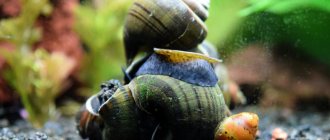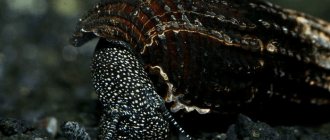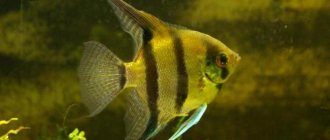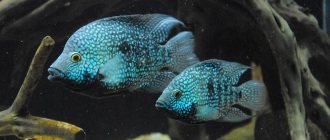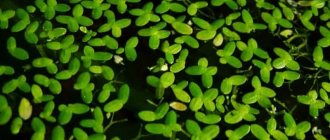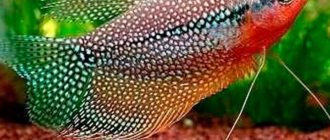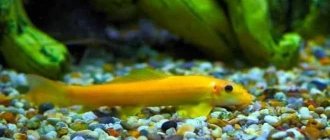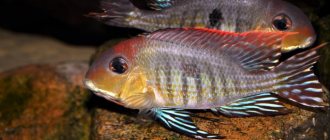Keeping ampularia snails at home
When grown at home, ampularia is not capable of causing much trouble to its owner, so this particular type of gastropod is very often chosen by beginning aquarists who are limited in time or do not have sufficient experience in keeping such snails.
Ampularia is a real decoration of the aquarium due to its unusual and exotic appearance. An adult specimen of such a snail is simply a fantastic sight and amazes those around with its waving tentacles, chewing radulae, unusual scraping tongue and pronounced eyes.
Criteria for choosing an aquarium
Despite the absolute unpretentiousness, the ampoule needs to be provided with comfortable living conditions, adhering to the following simple recommendations:
For each adult snail there should be about ten liters of clean water; the aquarium must be provided with soft soil, plants with hard leaves and frequent water changes; It is very important to choose the right “neighbors” of the ampoule to keep in the same aquarium.
The main mistake that novice aquarists make is adding snails of this species to predatory fish.
Proper equipment of the aquarium requires special attention. It is mandatory to have a lid with ventilation holes, which will not allow the snails to crawl out of the aquarium.
Water requirements
Gastropods are unpretentious in terms of water hardness and purity, and the temperature can vary between 15-35°C, but the most comfortable temperature is 22-24°C or slightly higher. Despite the fact that the snail lives primarily under water, every ten to fifteen minutes the snail must receive oxygen from the atmosphere.
If a gastropod crawls out of the water too often and very actively, this may be evidence of insufficient quality of habitat. In this case, you need to urgently change the water in the aquarium.
Care and maintenance of ampularia
According to experienced aquarists, it is best to keep the snail in a separate aquarium, the volume of which should be sufficient to provide the snail with optimal conditions. The best option is to keep the gastropod in the same aquarium with any small species of viviparous fish or catfish.
Nutrition and diet
In natural conditions, snails, as a rule, feed on food of plant origin. At home, the following are used as protein feed:
- earthworms;
- small bloodworm;
- Daphnia and small tubifex.
When kept in aquarium conditions, the diet of the gastropod must be varied, which will protect the vegetation from being eaten by ampullaria.
Vegetables must be boiled before cooking, and greens must be scalded with boiling water. Dry granulated food has proven itself well. Ampoules are very fond of crushed banana and boiled egg yolk, as well as white bread crumbs and pond duckweed.
Ampularia propagation and breeding
Ampularia belongs to the category of bisexual gastropods, and oviposition occurs on land. After fertilization, the adult looks for a comfortable and safe place to lay eggs. The diameter of the laid eggs does not exceed 2 mm. The eggs are attached to the surface of the aquarium wall.
Over time, the egg laying becomes quite dark, and the young are born after about three weeks and begin to actively feed on small food in the form of cyclops. The water in an aquarium for young animals must be filtered and then enriched with oxygen.
Lifespan
The average lifespan of ampullaria directly depends on the temperature in the aquarium. At optimal water temperatures, a snail can live for about three to four years. If the aquarium is filled with very soft water, the ampullaria will suffer greatly from insufficient calcium. As a result, the shell of the gastropod is destroyed, and the snail quickly dies.
Reproduction of other types of snails
Let's look at how other popular types of mollusks mate and how to breed them in an aquarium:
- Melanias are viviparous snails. They can reproduce by parthenogenesis, that is, without fertilization of the female by the male. Young individuals are born full-fledged. More than 10 cubs are born in one birth.
- Pagodas are livebearers and reproduce once a year. Childbirth occurs a month after mating.
- Maryses mate for almost 24 hours. Snail eggs in the aquarium appear every 4-5 days and mature within a week. In males, the fleshy leg is light with brown speckles, in females it is dark brown with black spots.
- The coils are multiplying rapidly. What does caviar look like: it is translucent, similar to bubble wrap, but hard. The young appear after 3-4 weeks.
- Physidae are characterized by rapid reproduction. About 20 laid eggs mature in a month.
- Neretina breed in warm salted water. Since there is no sexual dimorphism, 8-10 individuals are selected in preparation for reproduction.
- Predatory helenas lay 1-2 eggs. After spawning, they bury themselves in the ground and come to the surface only six months later.
- Tylomelania lay 2 eggs. Preparation for spawning includes installing a separate tank.
In most species, eggs take up to a month to develop. If after this period the young animals have not hatched, the clutch will have to be destroyed: it is dead.
Mr. Tail recommends: maintenance and care in the aquarium
To breed one individual, 10 liters of water is enough. As a rule, snails are placed together with fish. Then you need a home tank with a volume of at least 120 liters. The water should be of medium hardness, not soft, so as not to crack the shell.
Water temperature + 20…+ 24 °C. At lower temperatures, mollusks live longer, but they move little. When high, they are very active, multiply rapidly, but their lifespan is reduced. To prevent individuals from escaping, the tank is covered, leaving a gap of 10-15 cm for oxygen access and regular floating of the snail. Filters and water changes are also required.
The soil needs to be cleaned regularly, so owners often refuse it, although this is wrong, the mollusks need to move, clinging to stones. Use small pebbles for this. Individuals are not picky about light, but if lamps are installed, they like it.
Plants are selected with hard leaves. A change of place of residence, different food and water can cause stress to the snail, and then it changes color.
Among the diseases, it suffers from calcium deficiency, and the shell is destroyed. For prevention, chalk, eggshells, sepia, and feed shells are added to the water.
With the appearance of mites, depressions on the shells are observed - the shell is wiped with a soft cloth and treated with formaldehyde.
If the shell turns white and is covered with fluff, this is a sign of a parasite attack. A salt solution (10 grams per liter of water) helps. Place the snail for 15 minutes.
During a coma, the ampularia falls asleep and does not crawl out of its shell. This is due to a lack of oxygen - the snail is placed in a spacious tank.
Content
The temperature range is not important for them, it can be between 15 and 35 degrees, but it is still better to maintain an average value. At lower temperatures, snails do not reproduce and their life cycle slows down. And at high rates, on the contrary, it increases sharply, they quickly age and die before the age of one year.
Nutrition
The benefits from them are invaluable; they eat absolutely all types of food, and there is often no need to feed snails separately. But this is provided that food falls to the bottom and they get it. If there is not enough food, then they can begin to eat young shoots of plants. They also clean glass and plant leaves, but the larger the snail, the less it cleans their surface. Feeding ampullaria does not require a special description; for them to live well, you just need a voluminous aquarium and food that sinks to the bottom and goes to the snails. Although even without sinking food they will find food for themselves.
All types of ampularia are extremely voracious. The more they eat, the faster they grow, and from small snails they quickly turn into large and beautiful individuals of their species. Ampularia grow quickly; with good nutrition, they grow to their maximum size in a matter of months.
How to regulate the number of snails in an aquarium
Despite the benefits of shellfish, you need to monitor their quantity. Too many snails pollute the water, spoil plants and eat fish eggs. Owners resort to several methods of getting rid of shellfish:
- Mechanical - young animals are collected, crushed and fed to other inhabitants of the reservoir.
- Thermal - the masonry is frozen, crushed and fed to fish and snails.
- Biological - they keep predatory fish (cichlids, barbs, tetraodons) or helenas, which eat other mollusks and caviar.
To catch shellfish, traps are used - a cabbage leaf scalded with boiling water is placed on the bottom, and in the morning snails will gather on it. Or they take a plastic bottle and make a hole for gastropods so that fish cannot get in.
There are also chemical and electrical methods of getting rid of snails, but then the entire aquarium with other inhabitants will suffer. Otherwise, they breed snails that are unable to reproduce in fresh water.
Ampularia snail how to determine gender
Almost all aquarists who are not highly specialized specialists in this field talk about some difficulties in determining the gender of specific specimens of ampullaria. This is especially difficult to do when buying them in a store, when the snails are still very small. But the combined experience of all owners of these snails allows us to identify the following methods for determining the sex of the ampularia:
- If the shell structure has already been formed, the sex of the snail can be determined by the direction of its curls. If they are twisted clockwise, then it is a male; if in the opposite direction, it is a female;
- If the mouth of the snail shell has a round shape, then you have a male in front of you, and if it is oblong, then you have a female in your hands;
- If you catch the moment when the snail opens the flaps of its shell (it’s easier to do this in water), then seeing a characteristic sexual process in its upper part, you can conclude that this individual is male. Accordingly, the absence of such a process will indicate the female origin of this individual.
Features and description
To begin with, it is worth mentioning that snails are placed in an aquarium not just for beauty. They serve a more important and practical function. Shellfish can truly be of great benefit to the ecosystem of any aquarium. The main thing is to know which snails are suitable for your aquarium and which are not.
Ampoules very often become inhabitants of home aquariums. These creatures can reach a length of up to 15 cm. You can often find bright yellow snails. Less common are black or white specimens. Since these mollusks have a very keen sense of smell, they can quite easily find food in any environment.
On average, such snails live 4 years. But this is provided that the most comfortable conditions are created for them.
Before you have such mollusks in your home aquarium, you definitely need to find out what benefits they can bring, and whether their proximity will harm the fish.
Myths about reels
The benefits and harms of snail coils are a point that causes controversy among aquarists. Reels are considered the most popular aquarium clams. It is for this reason that many myths are born around them.
Aquarium snail coils do more good than harm
Among which:
- Shellfish harm healthy plants. This is a myth. Snails have a rather poorly developed jaw. Therefore, they cannot destroy hard plant leaves and algae.
- Coils carry a large number of infectious diseases. There is some truth here. However, it should be borne in mind that disease carriers are wild specimens that accidentally entered the aquarium. For this reason, it is recommended to purchase all livestock from pet stores. Withstand quarantine.
- Reproduction. This is true. In the absence of predators that feed on shellfish, reproduction occurs quickly. It is recommended to monitor the population.
Reels are considered the most popular aquarium shellfish
Aquarium snail coils do more good than harm. But this requires monitoring their population. Avoid overbreeding.
Description of Ampularia
| Kingdom | Animals |
| Type | Shellfish |
| Class | Gastropods |
| Squad | Mesogastropods |
| Family | Ampullariidae |
| Genus | Pomacea |
Almost no different from its relatives in the prosobranch subclass. All of them belong to the class of gastropods.
This is an invertebrate animal with a well-developed sense of smell.
Appearance
The snail's body has a head with a pair of tactile tentacles, a leg and an internal sac. The bag is covered with a spirally curled shell. The long muscular leg is used for movement. On the back there is a lid that seals the mouth of the shell in case of danger.
The size of the aquarium ampoule depends on the species and can range from 5 cm to 15 cm.
The complex respiratory system is of interest. The snail has gill slits on the right side. They supply oxygen dissolved in water. On the left side are the lungs. Ampularia lives under water. But about once every ten minutes she needs to receive atmospheric oxygen. To do this, the animal rises to the surface, extends the breathing tube-siphon and rhythmically sucks in air.
Instead of jaws, snails have special graters - radulas. They use them to scrape off food.
There are eyes. But mollusks hardly see. They can only distinguish a dark object from a light one.
FACT: Ampularia has the ability to regenerate. Within a month, she will regrow any lost organ, including her eyes.
Types of snail
Attracts with its variety of colors. In nature, the shell of the mollusk is light brown. Selection has achieved a wide range of colors. White, black, and blue ampoules are not uncommon. The shells are often decorated with stripes of lighter shades.
The most common color is yellow.
Fact: Snails respond to stressful situations by stopping their growth. A change of place of residence, unusual food and even water can upset them. When the snail calms down, the shell is restored. But the uneven color remains. It does not affect the pet's health.
The genus Pomacea includes several dozen species.
They differ from each other in the size and shape of the shells.
Fans of aquarium snails are familiar with golden, Australian and giant Pomacea.
Golden ampularia
Named for the color of their shell. Several morphs are popular among hobbyists.
- Pomacea bridgesi is called the mystery snail. The adjacent coils of the shell have flat slopes. Bridgesi can reach seven centimeters. Another popular name is Cinderella. But not for the yellow color of the shell. They spend time in the aquarium in constant work: scraping growths from the walls, removing rotting algae.
- Pomacea canaliculata has a rounded shell. One turn seems to creep onto another. The snail grows up to eight centimeters.
- Marisa comuarietis differs from its fellows in its unusual appearance. It's called a giant coil. The shell, about 3 cm in diameter, has dark stripes. But it can also be monochromatic. The coils are located in the same plane.
- Pomace apaludosa is a resident of Florida and is rarely found in Russian stores. It has a cone-shaped top. Its size ranges from 4 to 6.5 cm
Fact: Do ampularia spoil plants? Only Pomacea bridgesi, due to its physiological characteristics, does not damage plants in the aquarium. Yellow snails have soft teeth. Bridgesi can only process rotten pieces of algae.
Giant ampullaria
. Rare representatives of the class are impressive in size. The shell reaches a diameter of 10-12 cm. The leg is up to 15 cm. The only species whose color depends on age. Babies are born black (sometimes brown). As it grows, the shell becomes lighter and yellow stripes appear.
The giant ampularia has beautiful golden eyes. It is rightfully considered the decoration of an aquarium.
Australian ampullaria
Large snails with a keen sense of smell and wonderful eyes. The leg length of an adult reaches up to 9 cm. The diameter of the shell is 7 cm. It loves aquariums overgrown with algae. The complete absence of vegetation will not upset her either. The snail will eagerly consume the remaining fish food.
Fact: How much longer will an already large snail grow? It depends on the species. If you are not the happy owner of a giant exotic, then the growth of the mollusk will not exceed eight centimeters.
Fans of the aquatic world appreciate Pomacea for its decorative qualities and unpretentiousness.
Keeping ampularia in an aquarium
Ampoules can be kept in an aquarium with a volume of 20 liters or more, with at least 5 liters of water per mollusk. The water must be clean , so a filter is needed in the aquarium. Regular water changes in the container are also required.
The temperature in the aquarium where such pets are kept can be from 18 to 30 degrees, that is, the ampoule snail is suitable for sharing with various tropical fish. At high temperatures, the activity of ampularia increases sharply, making them very interesting to watch. True, they live at this temperature noticeably less, a year and a half.
Considering the natural habitat of ampullaria, one can guess that they are undemanding to water quality. But you need to know that a lack of calcium in the water can cause the destruction of the mollusk shell. To saturate the water with calcium, it is enough to place fragments of sea shells or limestone on the bottom of the aquarium. If a natural source of calcium is not at hand, then there are special preparations on sale that increase water hardness.
Ampularia is a peaceful aquarium inhabitant , so it easily gets along with all its inhabitants. But their eggs and offspring, as well as themselves, can become prey for turtles and some species of fish. Crustaceans can easily pull a mollusk out of its shell and eat it.
It’s another matter when fish can disturb the ampoule, tearing off its antennae or piercing the shell. If someone tears off part of a snail's body, it will quickly recover. The ability to regenerate is the best that nature has given them. Ampularia restores all parts of the body, even the eyes.
If the fish in an aquarium with snails get sick, you need to be careful with the use of medications - what is beneficial for the fish is fatal for the mollusk, since aquarium species are biologically closer to parasites than to fish. When treating fish, temporarily remove snails from the aquarium . Place them in a glass jar with a volume of 5 liters or more, covering it with glass. There should be a hole between the glass and the jar for air access.
Diseases of ampularia are little known to the general public, with the exception of ulcers that appear on the shells. The destruction of the snail's house is associated with low water hardness and suboptimal feeding. To build a high-quality shell, your pet needs a lot of calcium compounds.
The lifespan of the ampularia snail depends on the water temperature and conditions. At high water temperatures, 26 - 28 degrees, and non-ideal conditions, the ampullary eyelids can last only a year or a year and a half and the snail dies of old age. Therefore, in most cases, it is easier to get offspring or acquire young mollusks than to treat old ones.
Ampoules are incompatible with: Sumatran barbs, green tetradon, clown loach, fakaka, large cichlids. Shrimp and crayfish will also cause trouble for snails - they can pick out the snail's body from the shell and eat it.
You can keep ampularia with any non-aggressive fish. And, for example, cichlids will always strive to bite off its whiskers, or pull out the entire snail by them. Labyrinths also cannot peacefully coexist with these mollusks. An aquarium with these mollusks must have a lid , since ampullaria are big fans of traveling.
Snail farming
Ampularia are dioecious creatures, therefore, in order to produce offspring, you need to have at least one pair in the aquarium. It is impossible to determine their gender by any external signs, but they are not hermaphrodites. Therefore, to be on the safe side, it is best to have four to six of these clams.
You can understand where the female or male is during mating, since the latter will always be on top. Reproduction of aquarium ampularia snails occurs in the warm season or at water temperatures above 25 degrees.
For snails to reproduce, a male and female snail is required.
The eggs themselves are large, reaching approximately 2 mm in diameter. At the very beginning they are pale pink in color, but after a few days they turn white. Thanks to the air, the eggs are calcified, and the larvae are safe. All eggs fit tightly together, and the clutch itself resembles a small bunch of grapes. A few days before the mollusks appear, the clutch becomes almost black.
Ampoule eggs change color as they ripen
After about three weeks, the snails begin to hatch. They are still small, but in appearance they no longer differ from adults. To prevent the masonry from dying, you need to carefully monitor the humidity in the aquarium. And when the snails begin to appear, the aquarium should be covered with glass. In this case, they will crawl down towards the water, and not out, and will not die.
There are also situations when ampullaria snails do not reproduce in an aquarium, even though there is both a male and a female. In this case, the following conditions should be created for them:
- change the water in the aquarium at least once a week;
- increase the frequency of feedings;
- increase the water temperature in the aquarium.
To stimulate ampullaria to reproduce, you can try increasing the water temperature.
If all these three conditions are met, then it will soon be possible to observe the reproduction of ampullaria in the aquarium. If the snail finds a good place for spawning, then it will constantly lay eggs there
It is important to know not only how to breed mollusks, but also what to feed the hatched young. After all, young snails need constant good nutrition and, of course, they will not have enough of the food that falls to the bottom while feeding other fish
Therefore, you can put pre-scalded lettuce leaves in the aquarium for them.
We must not forget about additional aeration of the water, which it is advisable to do twice a day for at least 10 minutes. But you need to change the water in the sedimentation tank once every three days. When the new offspring grows up and gets stronger, they can be transplanted into a common aquarium.
Breeding and keeping ampullaria snails is not difficult. They are undoubtedly the decoration of any aquarium and are very interesting to watch.
Conditions necessary for reproduction
Breeding ampularia at home is not difficult if certain conditions are created. They are necessary not only for producing offspring, but also simply for the quality of life of the ampoule. The main parameters necessary for the reproduction of mollusks are these three:
- Quality feeding. Snails cannot swim, which is why they feed on food from the bottom. If bottom dwellers or fish swimming on the surface overtake their armored neighbors and collect food from the bottom, then the latter will begin to eat plants, but they will not have enough of them. Due to a lack of nutrients, the snails will be quite weak and will not be able to produce full-fledged offspring.
- Keeping the water clean. Like fish, ampullaria require regular water changes in your home pond and mandatory cleaning of the bottom. This should be done at least once every 7 days. A quarter of the aquarium's volume needs to be replaced.
- The presence of space between the aquarium lid and the water. If there is not enough volume under the glass (lid) above the water, then the females will have nowhere to lay eggs, and reproduction will be impossible .
If all the necessary conditions are available in the aquarium, propagation of ampularia will not cause any difficulties. Snails, having reached sexual maturity, quickly begin to mate and lay eggs.
Breeding
Mollusks reproduce in spring and summer. After mating, the female lays eggs, usually in the evening, outside, on the walls of the tank. Owners can prepare the place in advance - attach a piece of polystyrene foam or a plastic bottle to the glass of the aquarium. If the masonry falls into the water, it will disappear. Also, do not allow the eggs to be heated by a lamp, otherwise there will be no offspring.
During the ripening process, the laid pink eggs change color and become darker. The offspring appears after a few weeks; the temperature must be maintained at +21...+27 °C. The humidity should be high, and you need to make sure that condensation does not get on the masonry. When the eggs hatch, they end up in the water and live independently.
They are fed scalded cyclops, lettuce, and duckweed. The water is changed regularly. If desired, the parents can be placed in a separate container, creating the same conditions as in an aquarium, and removed after the eggs have formed. Snails reproduce often and then they will become crowded.
Fish and snails: friends or enemies?
Snails play the role of “aquarium orderlies”. After the death of an aquarium fish, snails immediately begin to eat it. However, they should not be allowed to do this. It is necessary to remove the dead fish from the aquarium immediately, without waiting for the snails to eat it. Otherwise, the water will inevitably become filled with nitrogen compounds. Snails are not able to eat live aquarium fish, as they are unable to catch up with them. At the same time, many aquarium fish willingly feast on live snails. These fish include gouramis, tetradons, and cichlids. Many aquarists breed snails to feed them to fish. This allows them to save money on food purchases.
Description and characteristics
Decorative types of ampullaria have long been familiar to fans of the underwater depths - the unpretentiousness, visual appeal and benefits of ampullaria snails have made the mollusks popular in the aquarium hobby.
The appearance of these gastropods is typical for all representatives of the genus: the shell is in the form of a spiral, and the color of the shell varies depending on the species. There are three varieties: golden, giant and Australian. Popular among aquarists are the yellow (golden) ampullaria and the color subspecies that were bred thanks to the efforts of breeders: white, blue, pink, black and blue ampullaria. The blueberry variety is also beautiful - a snail with a dark purple shell that looks great on light-colored soil.
The size of the ampularia in the aquarium depends on the diet and capacity of the container, but usually the dimensions of the mollusks do not exceed 10-15 cm. A distinctive feature of snails is their acute sense of smell, thanks to which pets recognize the appearance of food and rush to the food source. Many aquarists, before getting a mollusk, are interested in how long ampularia live. If the snail is kept in the aquarium correctly, the pet will live up to 3-4 years.
Description
The snail is a representative of freshwater mollusks. In nature, they live in overgrown reservoirs with weak currents. It is adapted to survive even in very dirty bodies of water with low oxygen content in the water. This ability is due to the presence of a kind of lungs that allow her to breathe atmospheric air.
The snail's shell resembles a flat, tightly wound spiral. There are usually four to five whorls, with each subsequent whorl thickening. The seam between the turns is clearly visible on both sides. The mollusk can reach sizes up to 3.5 centimeters in diameter, but most often in an aquarium, coils grow only up to 1 centimeter. By the way, the larger the snail population, the smaller they will be.
The body color can vary from brown to bright red, depending on the type of coil. The mollusk moves with the help of a leg with a wide flat base-sole. Thin long horns are visible on the head.
The snail can also move along the surface of the water, turning its shell down - this ability occurs due to the air bubble that is located in the shell. In case of danger, she immediately releases this bubble and falls to the bottom. Newborn small snails usually stick together, clinging to aquarium plants.
Girl or boy?
Even if we agree that Achatina (or other types of land mollusks) are hermaphrodites, this does not mean that they can give birth without the participation of a second individual. Each snail has male and female reproductive organs. Therefore, mollusks are able to mate with each other. As a result, genetic material is transferred from one of them to the other.
In a “family” pair of snails, each of them has its own role. It has been noticed that the responsibilities of the female are taken over by larger and more mature mollusks. Accordingly, young Achatina, which are smaller in size, become males.
If it is decided to breed snails, and there is only one individual available, a pair is selected for it, based on the size and age of the partner. This way, it will be possible to know exactly what sex the snail is.
It also happens that two Achatina live in a home terrarium, but the pair of them does not form and there may be no offspring at all. Even bisexual mollusks are not always able to create a “family,” which must be taken into account when forming a pair.
But it also happens the other way around: each of the snails begins to lay eggs.
Achatina is a bisexual creature, so there’s no need to rack your brains about what name to call her. Each individual can have either a female or a male name. This will depend solely on the personal preferences of its owner.
Being in the same container, two mature individuals can lay clutches one faster than the other. As a result, a large number of newborn snails will be born. If the mollusks do not like each other, there may be no offspring at all.
Diseases
usually causes incorrect content.
Problems with the sink due to lack of calcium.
What to do? Provide quality care.
Why does the ampularia's shell collapse? She doesn't have enough calcium. You can help by adding natural chalk, a shell or an eggshell to the water. Be sure to chop! It’s a good idea to put a sepia (cuttlefish skeleton) in the aquarium. It contains a lot of proteins. It is easy for snails to scrape it off.
Ticks. Symptoms of the disease: depressions on the shells.
What to do? The following procedure will help. Remove the snail from the water and wipe the shell with a soft cotton cloth.
Soak a cotton swab with a solution containing formaldehyde (for example, anti-steam) and wipe the sink. Important! Do not allow liquid to come into contact with the snail's body. If signs of the disease are found on one ampullary, all individuals must be subjected to preventive treatment.
Other parasites can also live on snails. Sometimes a white coating, similar to fluff, appears on the shells.
Place your pet for 15 minutes (no more!) in a salt solution: 10 g. per liter of water.
Coma. Happens due to poor maintenance in the aquarium. The animal lacks oxygen. Symptoms: the snail is alive, but does not crawl out of its shell. Place the ampularia in a glass jar with water.
Tip: How to remove green deposits on sinks? This is not a disease. You can clean the shell with a damp soft toothbrush. Do not use detergents!
Breeding ampularia
It is almost impossible to understand where the male is and where the female is. Therefore, among not very experienced aquarists there is an opinion that all snails are hermaphrodites. This opinion is incorrect, however, it is impossible to determine the sex of a gastropod until the individual begins to lay eggs. After this, it is better to mark the female in a convenient way, so that you know for sure in the future.
People who want to breed ampullaria immediately face the problem of how to distinguish a male from a female, because for mating they need mollusks of different sexes. There is only one way out in this situation - place a small group of snails in the aquarium and hope that there will be suitable individuals among them.
Ampularia reach maturity at 13-15 months. They will lay enough eggs only in the right conditions:
- temperature not lower than 26 and not higher than 28 degrees;
- excess food provided by the owner;
- the distance between the aquarium lid and the water is at least 10-15 cm. You may have to remove some of the water for this.
Very often, ampullaria lay their eggs on the walls of the aquarium.
Offspring will appear only from wet eggs
Therefore, it is important to protect them from drying out. But they shouldn’t be wet either, which means they shouldn’t be allowed to slip into the water.
A dense clutch does not form immediately - the snails lay eggs one at a time, gluing them to one another. The color of caviar can vary from white to pink or even green. Usually the shade is visible already on the third day after the masonry appears.
Caring for fry
The clutch can mature in 3 to 4 weeks. You can notice the peak of its maturity - the eggs become darker. As soon as the snails begin to fall into the water, they must be isolated from other fish that happily feast on them.
Since moving the fry is problematic, it is advisable to do this while they are still inside the eggs. That is, it is easier to move the entire masonry at once. This is done like this:
- we wet the caviar and the surface on which it is attached;
- We wait a minute, and then we move the masonry onto a convenient object.
Thus, you can easily control the number of snails in the aquarium.
Video: calf transplant
There is a more labor-intensive option. We take the mature hard masonry with our hands, divide it into 2 parts and hold it over the aquarium under a gentle stream of water. Then carefully remove the fry from the eggs.
To feed the fry, you should stock up on soft seaweed or fish food processed into pulp. Also suitable:
- boiled egg yolks, rubbed with your fingers;
- boiled beef twisted through a meat grinder;
- daphnia.
You can give regular snail food 4-5 weeks after hatching. Babies should be gradually transferred to this food starting from the 10th day of their birth. As soon as their body length reaches 5 mm, their dispersal needs to begin.
Sexual dimorphism
Ampularia are heterosexual, and to obtain offspring you need to have a male and a female. Sexual dimorphism is not expressed. Only the snails themselves can distinguish males from females. Even if you look under the cap, it is unlikely that you will be able to determine the gender. The only way to determine the sex of a snail is to watch the snails as they mate. The male is always on top.
There is no sexual dimorphism in ampullaria, however, by following the pair during mating, you can track the male individual.
In captivity there are a large number of subspecies that can even reproduce in their own way. All these mollusks are called ampullaria. The most popular are yellow ampullaria, which are actually albinos. The usual ampularia lays eggs above the water level, in a dry place.
In order to be guaranteed to obtain offspring, you should purchase at least 4-6 copies. Among such a number of snails, there is guaranteed to be at least one pair consisting of a female and a male. If there are ampullaria of different sexes in the reservoir, reproduction will not cause big problems.

